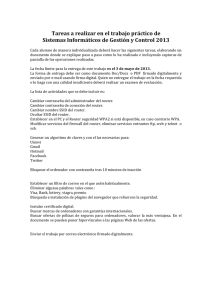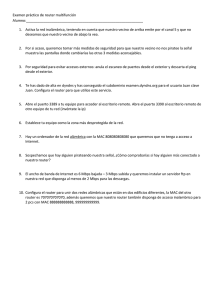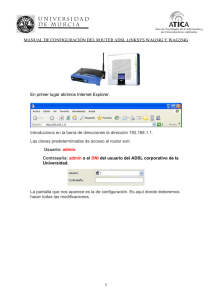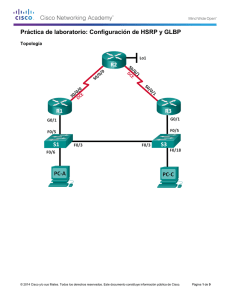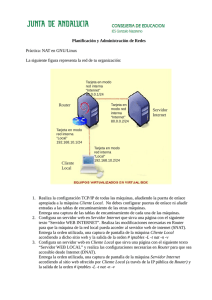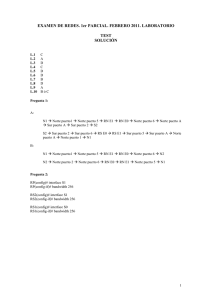Configuración de funciones de alta disponibilidad para VPN
Anuncio
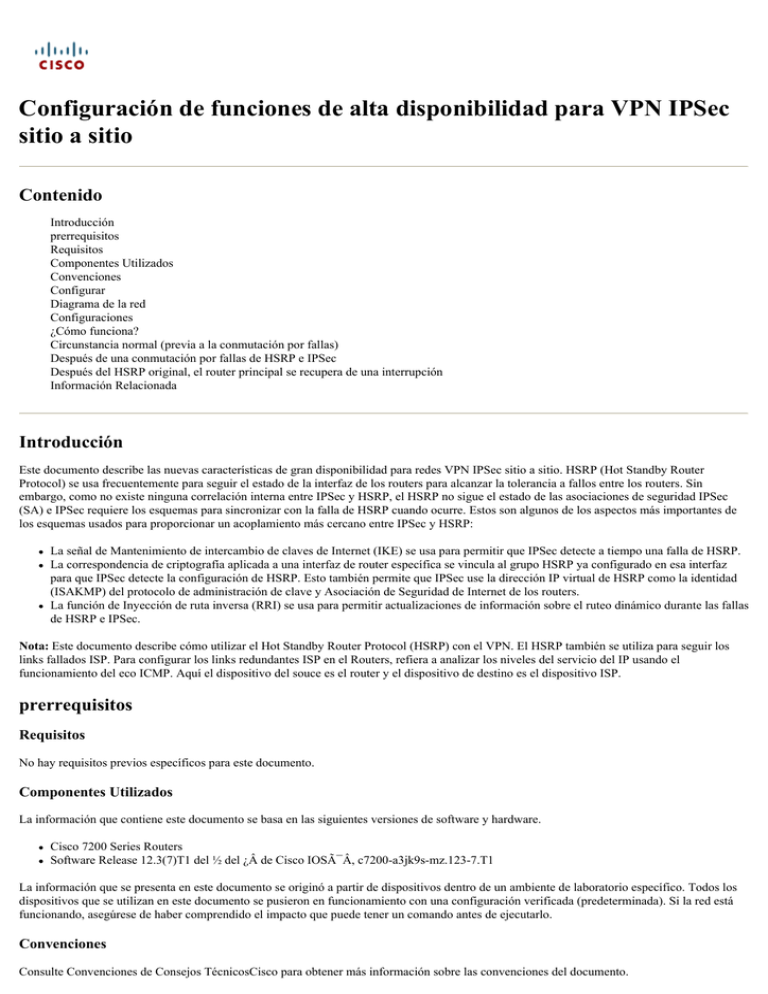
Configuración de funciones de alta disponibilidad para VPN IPSec
sitio a sitio
Contenido
Introducción
prerrequisitos
Requisitos
Componentes Utilizados
Convenciones
Configurar
Diagrama de la red
Configuraciones
¿Cómo funciona?
Circunstancia normal (previa a la conmutación por fallas)
Después de una conmutación por fallas de HSRP e IPSec
Después del HSRP original, el router principal se recupera de una interrupción
Información Relacionada
Introducción
Este documento describe las nuevas características de gran disponibilidad para redes VPN IPSec sitio a sitio. HSRP (Hot Standby Router
Protocol) se usa frecuentemente para seguir el estado de la interfaz de los routers para alcanzar la tolerancia a fallos entre los routers. Sin
embargo, como no existe ninguna correlación interna entre IPSec y HSRP, el HSRP no sigue el estado de las asociaciones de seguridad IPSec
(SA) e IPSec requiere los esquemas para sincronizar con la falla de HSRP cuando ocurre. Estos son algunos de los aspectos más importantes de
los esquemas usados para proporcionar un acoplamiento más cercano entre IPSec y HSRP:
La señal de Mantenimiento de intercambio de claves de Internet (IKE) se usa para permitir que IPSec detecte a tiempo una falla de HSRP.
La correspondencia de criptografía aplicada a una interfaz de router específica se vincula al grupo HSRP ya configurado en esa interfaz
para que IPSec detecte la configuración de HSRP. Esto también permite que IPSec use la dirección IP virtual de HSRP como la identidad
(ISAKMP) del protocolo de administración de clave y Asociación de Seguridad de Internet de los routers.
La función de Inyección de ruta inversa (RRI) se usa para permitir actualizaciones de información sobre el ruteo dinámico durante las fallas
de HSRP e IPSec.
Nota: Este documento describe cómo utilizar el Hot Standby Router Protocol (HSRP) con el VPN. El HSRP también se utiliza para seguir los
links fallados ISP. Para configurar los links redundantes ISP en el Routers, refiera a analizar los niveles del servicio del IP usando el
funcionamiento del eco ICMP. Aquí el dispositivo del souce es el router y el dispositivo de destino es el dispositivo ISP.
prerrequisitos
Requisitos
No hay requisitos previos específicos para este documento.
Componentes Utilizados
La información que contiene este documento se basa en las siguientes versiones de software y hardware.
Cisco 7200 Series Routers
Software Release 12.3(7)T1 del ½ del ¿Â de Cisco IOSïÂ, c7200-a3jk9s-mz.123-7.T1
La información que se presenta en este documento se originó a partir de dispositivos dentro de un ambiente de laboratorio específico. Todos los
dispositivos que se utilizan en este documento se pusieron en funcionamiento con una configuración verificada (predeterminada). Si la red está
funcionando, asegúrese de haber comprendido el impacto que puede tener un comando antes de ejecutarlo.
Convenciones
Consulte Convenciones de Consejos TécnicosCisco para obtener más información sobre las convenciones del documento.
Configurar
En esta sección encontrará la información para configurar las funciones descritas en este documento.
Nota: Utilice la herramienta Command Lookup Tool (clientes registrados solamente) para obtener más información sobre los comandos
utilizados en esta sección.
Diagrama de la red
En este documento, se utiliza esta configuración de red:
Configuraciones
En este documento, se utilizan estas configuraciones:
Configuración de VPN 7200 de Cisco
Configuración de Cisco 7204VXR-1
Configuración de Cisco 7204VXR-2
Configuración de Cisco 7206-1
Configuración de VPN 7200 de Cisco
vpn7200#show run
Building configuration...
Current configuration : 1854 bytes
!
version 12.2
service timestamps debug datetime msec
service timestamps log datetime msec
no service password-encryption
!
hostname vpn7200
!
!
ip subnet-zero
ip cef
!--- Defines ISAKMP policy and IKE pre-shared key for
!--- IKE authentication. Note that 172.16.172.53 is the
!--- HSRP virtual IP address of the remote HSRP routers.
crypto isakmp policy 1
hash md5
authentication pre-share
crypto isakmp key cisco123 address 172.16.172.53
!--- IKE keepalive to detect the IPSec liveness of the remote
!--- VPN router. When HSRP failover happens, IKE keepalive
!--- will detect the HSRP router switchover.
crypto isakmp keepalive 10
!
!
crypto ipsec transform-set myset esp-des esp-md5-hmac
!--- Defines crypto map. Note that the peer address is the
!--- HSRP virtual IP address of the remote HSRP routers.
crypto map vpn 10 ipsec-isakmp
set peer 172.16.172.53
set transform-set myset
match address 101
!
interface Loopback0
ip address 20.1.1.1 255.255.255.255
!
interface FastEthernet0/0
ip address 10.48.66.66 255.255.254.0
duplex full
speed 100
!
interface FastEthernet0/1
ip address 172.16.172.69 255.255.255.240
duplex full
speed 100
crypto map vpn
!
ip classless
ip route 10.1.1.0 255.255.255.0 172.16.172.65
ip route 99.99.99.99 255.255.255.255 172.16.172.65
ip route 172.16.172.48 255.255.255.240 172.16.172.65
no ip http server
!
access-list 101 permit ip 20.1.1.0 0.0.0.255 10.1.1.0 0.0.0.255
access-list 101 permit ip 20.1.1.0 0.0.0.255 host 99.99.99.99
!
line con 0
exec-timeout 0 0
line aux 0
line vty 0 4
login
!
end
Configuración de Cisco 7204VXR-1
7204VXR-1#show run
Building configuration...
Current configuration : 1754 bytes
!
version 12.3
service timestamps debug datetime msec
service timestamps log datetime msec
no service password-encryption
!
hostname 7204VXR-1
!
boot-start-marker
boot-end-marker
!
!
no aaa new-model
ip subnet-zero
!
!
no ip domain lookup
!
!
ip cef!
!--- Defines ISAKMP policy.
crypto isakmp policy 1
hash md5
authentication pre-share
crypto isakmp key cisco123 address 172.16.172.69
crypto isakmp keepalive 10
!
!
crypto ipsec transform-set myset esp-des esp-md5-hmac
!--- Defines crypto map. Note that "reverse-route"
!--- turns on the RRI feature.
crypto map vpn 10 ipsec-isakmp
set peer 172.16.172.69
set transform-set myset
match address 101
reverse-route
!
!
!--!--!--!--!--!--!--!---
Define HSRP under the interface. HSRP will track the
internal interface as well. HSRP group name must be
defined here and will be used for IPSec configuration.
The "redundancy" keyword in the crypto map command
specifies the HSRP group to which IPSec will couple.
In normal circumstances, this router will be the HSRP
primary router since it has higher priority than the
other HSRP router.
interface FastEthernet0/0
ip address 172.16.172.52 255.255.255.240
duplex full
speed 100
standby 1 ip 172.16.172.53
standby 1 priority 200
standby 1 preempt
standby 1 name VPNHA
standby 1 track FastEthernet0/1 150
crypto map vpn redundancy VPNHA
!
interface FastEthernet0/1
ip address 10.1.1.1 255.255.255.0
duplex full
speed 100
!
interface ATM1/0
no ip address
shutdown
no atm ilmi-keepalive
!
interface FastEthernet3/0
no ip address
shutdown
duplex half
!
interface ATM6/0
no ip address
shutdown
no atm ilmi-keepalive
!--!--!--!--!---
Define dynamic routing protocol and re-distribute static
route. This enables dynamic routing information update
during the HSRP/IPSec failover. All the "VPN routes"
that are injected in the routing table by RRI as static
routes will be redistributed to internal networks.
!
router ospf 1
log-adjacency-changes
redistribute static subnets
network 10.1.1.0 0.0.0.255 area 0
!
ip classless
ip route 172.16.172.64 255.255.255.240 172.16.172.49
no ip http server
no ip http secure-server
!
!
!--- Defines VPN traffic. The destination IP subnet will be
!--- injected into the routing table as static routes by RRI.
access-list 101 permit ip 10.1.1.0 0.0.0.255 20.1.1.0 0.0.0.255
access-list 101 permit ip host 99.99.99.99 20.1.1.0 0.0.0.255
!
line con 0
exec-timeout 0 0
stopbits 1
line aux 0
stopbits 1
line vty 0 4
!
!
!
end
Configuración de Cisco 7204VXR-2
7204VXR-2#show run
Building configuration...
Current configuration : 2493 bytes
!
version 12.3
service timestamps debug datetime msec
service timestamps log datetime msec
no service password-encryption
!
hostname 7204VXR-2
!
boot-start-marker
boot system flash disk1:c7200-a3jk9s-mz.123-7.T1
boot-end-marker
!
no aaa new-model
ip subnet-zero
!
!
no ip domain lookup
ip host rund 10.48.92.61
!
!
ip cef
!
crypto isakmp policy 1
hash md5
authentication pre-share
crypto isakmp key cisco123 address 172.16.172.69
crypto isakmp keepalive 10
!
!
crypto ipsec transform-set myset esp-des esp-md5-hmac
!
crypto map vpn 10 ipsec-isakmp
set peer 172.16.172.69
set transform-set myset
match address 101
reverse-route
!
!--- During normal operational conditions this router
!--- will be the standby router.
interface FastEthernet0/0
ip address 172.16.172.54 255.255.255.240
ip directed-broadcast
duplex full
standby 1 ip 172.16.172.53
standby 1 preempt
standby 1 name VPNHA
standby 1 track FastEthernet1/0
crypto map vpn redundancy VPNHA
!
interface FastEthernet1/0
ip address 10.1.1.2 255.255.255.0
ip directed-broadcast
duplex full
!
interface FastEthernet3/0
ip address 10.48.67.182 255.255.254.0
ip directed-broadcast
shutdown
duplex full
!
router ospf 1
log-adjacency-changes
redistribute static subnets
network 10.1.1.0 0.0.0.255 area 0
!
ip classless
ip route 172.16.172.64 255.255.255.240 172.16.172.49
no ip http server
no ip http secure-server
!
!
!
access-list 101 permit ip 10.1.1.0 0.0.0.255 20.1.1.0 0.0.0.255
access-list 101 permit ip host 99.99.99.99 20.1.1.0 0.0.0.255
!
line con 0
exec-timeout 0 0
transport preferred all
transport output all
stopbits 1
line aux 0
transport preferred all
transport output all
stopbits 1
line vty 0 4
login
transport preferred all
transport input all
transport output all
!
!
!
end
Configuración de Cisco 7206-1
7206-1#show run
Building configuration...
Current configuration : 1551 bytes
!
version 12.2
no service pad
service timestamps debug datetime msec localtime
service timestamps log datetime msec localtime
no service password-encryption
!
hostname 7206-1
!
ip subnet-zero
no ip source-route
ip cef
!
interface Loopback0
ip address 99.99.99.99 255.255.255.255
!
interface FastEthernet0/0
shutdown
duplex full
speed 100
!
!--- Define dynamic routing protocol. All the "VPN routes"
!--- will be learned and updated dynamically from upstream HSRP
!--- routers using the dynamic routing protocols.
interface FastEthernet0/1
ip address 10.1.1.3 255.255.255.0
duplex full
speed 100
!
router ospf 1
log-adjacency-changes
passive-interface Loopback0
network 10.1.1.0 0.0.0.255 area 0
network 99.99.99.99 0.0.0.0 area 0
!
ip classless
no ip http server
!
!
!
line con 0
exec-timeout 0 0
line aux 0
line vty 0 4
login
!
end
¿Cómo funciona?
Este ejemplo demuestra cómo el HSRP y la Conmutación por falla del IPSec trabajan juntos usando la configuración y la configuración
antedichas. Tres aspectos se resaltan en este caso estudian:
Falla de HSRP debido a error de interfaz.
Cómo se produce el error de IPSec tras un error de HSRP. Como puede ser visto, la Conmutación por falla del IPSec aquí será
Conmutación por falla “apátrida”.
Cómo los cambios en la información de ruteo causados por la Conmutación por falla son dinámicamente actualizados y propagados a las
redes internas.
Nota: El tráfico de prueba en este punto son los paquetes de protocolo de mensaje de control de Internet (ICMP) entre la dirección IP de
loopback de Cisco 7206-1 (99.99.99.99) y la dirección IP de loopback Cisco VPN 7200 (20.1.1.1) y simula el tráfico VPN entre dos sitios.
Circunstancia normal (previa a la conmutación por fallas)
Antes de la Conmutación por falla, Cisco 7204VXR-1 es el router HSRP primario y el Cisco VPN 7200 tiene SA de IPSec con Cisco 7204VXR1.
Cuando la correspondencia de criptografía se configura en la interfaz, la característica RRI inyecta una ruta VPN para hacer juego el Access
Control List configurado del IPSec (ACL) y la declaración de comando set peer en la correspondencia de criptografía. Esta ruta se agrega a la
tabla de ruteo del router HSRP primario 7204VXR-1.
La salida del comando debug crypto ipsec indica la adición de ruta 20.1.1/24 VPN al Routing Information Base (RIB).
IPSEC(rte_mgr): VPN Route Added 20.1.1.0 255.255.255.0
via 172.16.172.69 in IP DEFAULT TABLE
La tabla de ruteo en el router HSRP primario rinde una Static ruta a 20.1.1/24, que es redistribuida por el Open Shortest Path First (OSPF) al
router HSRP secundario, 7204VXR-2, y al router interno, 7206-1.
El salto siguiente para la ruta 20.1.1/24 VPN inyectado como Static ruta en el RIB del router 7204VXR-1 es la dirección IP del peer de
criptografía remoto. En este caso, el salto siguiente para la ruta 20.1.1/24 VPN es 172.16.172.69. La dirección IP del salto siguiente de la ruta
VPN se resuelve vía las operaciones de búsqueda de la ruta recurrente tal y como se muestra en de esta tabla del Cisco Express Forwarding:
7204VXR-1#show ip route
Codes: C - connected, S - static, R - RIP, M - mobile, B - BGP
D - EIGRP, EX - EIGRP external, O - OSPF,
IA - OSPF inter area, N1 - OSPF NSSA external type 1,
N2 - OSPF NSSA external type 2, E1 - OSPF external type 1,
E2 - OSPF external type 2, i - IS-IS, su - IS-IS summary,
L1 - IS-IS level-1, L2 - IS-IS level-2, ia - IS-IS inter area,
* - candidate default, U - per-user static route
o - ODR, P - periodic downloaded static route
Gateway of last resort is not set
O
S
C
S
C
S
99.0.0.0/32 is subnetted, 1 subnets
99.99.99.99 [110/2] via 10.1.1.3, 00:11:21, FastEthernet0/1
20.0.0.0/24 is subnetted, 1 subnets
20.1.1.0 [1/0] via 172.16.172.69
172.16.0.0/28 is subnetted, 2 subnets
172.16.172.48 is directly connected, FastEthernet0/0
172.16.172.64 [1/0] via 172.16.172.49
10.0.0.0/8 is variably subnetted, 2 subnets, 2 masks
10.1.1.0/24 is directly connected, FastEthernet0/1
10.48.66.0/23 [1/0] via 10.1.1.2
7204VXR-1#show ip cef 20.1.1.0 detail
20.1.1.0/24, version 66, epoch 0, cached adjacency 172.16.172.49
0 packets, 0 bytes
via 172.16.172.69, 0 dependencies, recursive
next hop 172.16.172.49, FastEthernet0/0 via 172.16.172.64/28
valid cached adjacency
El router HSRP secundario y el router interno 7206-1 aprenden esta ruta VPN vía el OSPF. Los administradores de la red no necesitan entrar la
Static ruta manualmente. Lo que es más importante, los cambios de ruteo causados por la Conmutación por falla se ponen al día dinámicamente.
7204VXR-2#show ip route
Codes: C - connected, S - static, R - RIP, M - mobile, B - BGP
D - EIGRP, EX - EIGRP external, O - OSPF,
IA - OSPF inter area, N1 - OSPF NSSA external type 1,
N2 - OSPF NSSA external type 2, E1 - OSPF external type 1,
E2 - OSPF external type 2, i - IS-IS, su - IS-IS summary,
L1 - IS-IS level-1, L2 - IS-IS level-2, ia - IS-IS inter area,
* - candidate default, U - per-user static route
o - ODR, P - periodic downloaded static route
Gateway of last resort is 10.48.66.1 to network 0.0.0.0
99.0.0.0/32 is subnetted, 1 subnets
99.99.99.99 [110/2] via 10.1.1.3, 00:29:31, FastEthernet1/0
20.0.0.0/24 is subnetted, 1 subnets
O E2
20.1.1.0 [110/20] via 10.1.1.1, 00:11:06, FastEthernet1/0
172.16.0.0/28 is subnetted, 2 subnets
O
C
S
172.16.172.48 is directly connected, FastEthernet0/0
172.16.172.64 [1/0] via 172.16.172.49
10.0.0.0/8 is variably subnetted, 2 subnets, 2 masks
C
10.1.1.0/24 is directly connected, FastEthernet1/0
C
10.48.66.0/23 is directly connected, FastEthernet3/0
S*
0.0.0.0/0 [1/0] via 10.48.66.1
7206-1#show ip route
Codes: C - connected, S - static, R - RIP, M - mobile, B - BGP
D - EIGRP, EX - EIGRP external, O - OSPF,
IA - OSPF inter area, N1 - OSPF NSSA external type 1,
N2 - OSPF NSSA external type 2, E1 - OSPF external type 1,
E2 - OSPF external type 2, i - IS-IS, su - IS-IS summary,
L1 - IS-IS level-1, L2 - IS-IS level-2, ia - IS-IS inter area,
* - candidate default, U - per-user static route
o - ODR, P - periodic downloaded static route
Gateway of last resort is not set
C
O
O
C
O
99.0.0.0/32 is subnetted, 1 subnets
99.99.99.99 is directly connected, Loopback0
20.0.0.0/24 is subnetted, 1 subnets
E2
20.1.1.0 [110/20] via 10.1.1.1, 00:14:01, FastEthernet0/1
172.16.0.0/28 is subnetted, 1 subnets
E2
172.16.172.64 [110/20] via 10.1.1.1, 00:32:21, FastEthernet0/1
[110/20] via 10.1.1.2, 00:32:21, FastEthernet0/1
10.0.0.0/8 is variably subnetted, 2 subnets, 2 masks
10.1.1.0/24 is directly connected, FastEthernet0/1
E2
10.48.66.0/23 [110/20] via 10.1.1.2, 00:32:22, FastEthernet0/1
El router 7204VXR-1 es el router HSRP primario que sigue el Fa0/1 de la interfaz interna.
7204VXR-1#show standby
FastEthernet0/0 - Group 1
State is Active
2 state changes, last state change 03:21:20
Virtual IP address is 172.16.172.53
Active virtual MAC address is 0000.0c07.ac01
Local virtual MAC address is 0000.0c07.ac01 (v1 default)
Hello time 3 sec, hold time 10 sec
Next hello sent in 0.172 secs
Preemption enabled
Active router is local
Standby router is 172.16.172.54,
priority 100 (expires in 7.220 sec)
Priority 200 (configured 200)
Track interface FastEthernet0/1 state Up decrement 150
IP redundancy name is "VPNHA" (cfgd)
Usted puede utilizar el comando show track de ver una lista de todos los objetos seguidos por el HSRP.
7204VXR-1#show track
Track 1 (via HSRP)
Interface FastEthernet0/1 line-protocol
Line protocol is Up
1 change, last change 03:18:22
Tracked by:
HSRP FastEthernet0/0 1
El router 7204VXR-2 es el router HRSP en espera. Bajo condiciones operativas normales, este dispositivo sigue la interfaz interna Fa1/0.
7204VXR-2#show standby
FastEthernet0/0 - Group 1
State is Standby
1 state change, last state change 02:22:30
Virtual IP address is 172.16.172.53
Active virtual MAC address is 0000.0c07.ac01
Local virtual MAC address is 0000.0c07.ac01 (v1 default)
Hello time 3 sec, hold time 10 sec
Next hello sent in 0.096 secs
Preemption enabled
Active router is 172.16.172.52,
priority 200 (expires in 7.040 sec)
Standby router is local
Priority 100 (default 100)
Track interface FastEthernet1/0 state Up decrement 10
IP redundancy name is "VPNHA" (cfgd)
Estos comandos show IPSec-relacionados rinden la salida en el router del Cisco VPN 7200 que demuestra el ISAKMP y el SA de IPSec entre el
Cisco VPN 7200 y el router HSRP primario, Cisco 7204VXR-1.
7204VXR-1#show crypto isakmp sa detail
Codes: C - IKE configuration mode, D - Dead Peer Detection
K - Keepalives, N - NAT-traversal
X - IKE Extended Authentication
psk - Preshared key, rsig - RSA signature
renc - RSA encryption
C-id
Local
Remote
I-VRF
1
172.16.172.53 172.16.172.69
Connection-id:Engine-id = 1:1(software)
Encr
des
Hash
md5
Auth
psk
DH
1
Lifetime
23:49:52
7204VXR-1#show crypto ipsec sa
interface: FastEthernet0/0
Crypto map tag: vpn, local addr. 172.16.172.53
protected vrf:
local ident (addr/mask/prot/port): (99.99.99.99/255.255.255.255/0/0)
remote ident (addr/mask/prot/port): (20.1.1.0/255.255.255.0/0/0)
current_peer: 172.16.172.69:500
PERMIT, flags={origin_is_acl,}
#pkts encaps: 5, #pkts encrypt: 5, #pkts digest: 5
#pkts decaps: 5, #pkts decrypt: 5, #pkts verify: 5
#pkts compressed: 0, #pkts decompressed: 0
#pkts not compressed: 0, #pkts compr. failed: 0
#pkts not decompressed: 0, #pkts decompress failed: 0
#send errors 0, #recv errors 0
local crypto endpt.: 172.16.172.53, remote crypto endpt.: 172.16.172.69
path mtu 1500, media mtu 1500
current outbound spi: 44E0B22B
inbound esp sas:
spi: 0x5B23F22E(1529082414)
transform: esp-des esp-md5-hmac ,
in use settings ={Tunnel, }
slot: 0, conn id: 2000, flow_id: 1, crypto map: vpn
crypto engine type: Software, engine_id: 1
sa timing: remaining key lifetime (k/sec): (4504144/2949)
ike_cookies: B57A9DC9 FA2D627B F70FEDF6 FAAF9E34
IV size: 8 bytes
replay detection support: Y
inbound ah sas:
inbound pcp sas:
outbound esp sas:
spi: 0x44E0B22B(1155576363)
transform: esp-des esp-md5-hmac ,
in use settings ={Tunnel, }
slot: 0, conn id: 2001, flow_id: 2, crypto map: vpn
crypto engine type: Software, engine_id: 1
sa timing: remaining key lifetime (k/sec): (4504145/2949)
ike_cookies: B57A9DC9 FA2D627B F70FEDF6 FAAF9E34
IV size: 8 bytes
replay detection support: Y
outbound ah sas:
outbound pcp sas:
vpn7200#show crypto isakmp sa
dst
src
172.16.172.53 172.16.172.69
state
QM_IDLE
conn-id
1
slot
0
7204VXR-2#show crypto ipsec sa
interface: FastEthernet0/1
Crypto map tag: vpn, local addr. 172.16.172.69
local ident (addr/mask/prot/port): (20.1.1.0/255.255.255.0/0/0)
remote ident (addr/mask/prot/port): (99.99.99.99/255.255.255.255/0/0)
current_peer: 172.16.172.53
PERMIT, flags={origin_is_acl,}
#pkts encaps: 10, #pkts encrypt: 10, #pkts digest 10
#pkts decaps: 10, #pkts decrypt: 10, #pkts verify 10
#pkts compressed: 0, #pkts decompressed: 0
Cap.
K
#pkts not compressed: 0, #pkts compr. failed: 0, #pkts decompress failed: 0
#send errors 5, #recv errors 0
local crypto endpt.: 172.16.172.69, remote crypto endpt.: 172.16.172.53
path mtu 1500, ip mtu 1500
current outbound spi: 5B23F22E
inbound esp sas:
spi: 0x44E0B22B(1155576363)
transform: esp-des esp-md5-hmac ,
in use settings ={Tunnel, }
slot: 0, conn id: 2029, flow_id: 1, crypto map: vpn
sa timing: remaining key lifetime (k/sec): (4607997/2824)
IV size: 8 bytes
replay detection support: Y
inbound ah sas:
inbound pcp sas:
outbound esp sas:
spi: 0x5B23F22E(1529082414)
transform: esp-des esp-md5-hmac ,
in use settings ={Tunnel, }
slot: 0, conn id: 2030, flow_id: 2, crypto map: vpn
sa timing: remaining key lifetime (k/sec): (4607998/2824)
IV size: 8 bytes
replay detection support: Y
outbound ah sas:
outbound pcp sas:
Después de una conmutación por fallas de HSRP e IPSec
La Conmutación por falla fue accionada apagando Fa0/0 en el Cisco 7204VXR-1. Usted verá el comportamiento similar si el otro interfaz, Fa0/1,
está abajo porque el HSRP también sigue el estatus de esta interfaz.
Cuando el Cisco VPN 7200 no recibe ninguna respuesta a los paquetes del keepalive IKE enviados al router HSRP primario, el router derriba el
SA de IPSec.
Esta salida del comando debug crypto isakmp muestra cómo el keepalive IKE detecta la caída del sistema del router primario:
ISAKMP (0:1): received packet from 172.16.172.53 (I) QM_IDLE
ISAKMP (0:1): processing HASH payload. message ID = 1585108592
ISAKMP (0:1): processing NOTIFY ITS_ALIVE protocol 1
spi 0, message ID = 1585108592, sa = 61C3E754
ISAKMP (0:1): sending packet to 172.16.172.53 (I) QM_IDLE
ISAKMP (0:1): purging node -1484552386
ISAKMP (0:1): deleting node 1585108592 error FALSE
reason "informational (in) state 1"
ISAKMP (0:1): purging node 642343711
ISAKMP (0:1): sending packet to 172.16.172.53 (I) QM_IDLE
ISAKMP (0:1): purging node -523181212
ISAKMP (0:1): purging node -2089541867
ISAKMP (0:1): incrementing error counter on sa: PEERS_ALIVE_TIMER
ISAKMP (0:1): sending packet to 172.16.172.53 (I) QM_IDLE
ISAKMP (0:1): purging node 1671177686
ISAKMP (0:1): incrementing error counter on sa: PEERS_ALIVE_TIMER
ISAKMP (0:1): sending packet to 172.16.172.53 (I) QM_IDLE
ISAKMP (0:1): purging node 1706520344
ISAKMP (0:1): incrementing error counter on sa: PEERS_ALIVE_TIMER
ISAKMP (0:1): sending packet to 172.16.172.53 (I) QM_IDLE
ISAKMP (0:1): purging node 503375209
ISAKMP (0:1): incrementing error counter on sa: PEERS_ALIVE_TIMER
ISAKMP (0:1): sending packet to 172.16.172.53 (I) QM_IDLE
ISAKMP (0:1): purging node 1272270610
ISAKMP (0:1): incrementing error counter on sa: PEERS_ALIVE_TIMER
ISAKMP (0:1): peer not responding!
ISAKMP (0:1): peer does paranoid keepalives.
ISAKMP (0:1): phase 1 going away; let's be paranoid.
ISAKMP (0:1): Bring down phase 2's
ISAKMP (0:1): That phase 1 was the last one of its kind.
Taking phase 2's with us.
ISAKMP (0:1): peer does paranoid keepalives.
ISAKMP (0:1): deleting SA reason "P1 errcounter exceeded
(PEERS_ALIVE_TIMER)" state (I)
QM_IDLE (peer 172.16.172.53) input queue 0
IPSEC(key_engine): got a queue event...
IPSEC(key_engine_delete_sas): rec'd delete notify from ISAKMP
IPSEC(key_engine_delete_sas): delete all SAs shared with 172.16.172.53
IPSEC(delete_sa): deleting SA,
(sa) sa_dest= 172.16.172.69, sa_prot= 50,
sa_spi= 0x44E0B22B(1155576363),
sa_trans= esp-des esp-md5-hmac , sa_conn_id= 2029
IPSEC(delete_sa): deleting SA,
(sa) sa_dest= 172.16.172.53, sa_prot= 50,
sa_spi= 0x5B23F22E(1529082414),
sa_trans= esp-des esp-md5-hmac , sa_conn_id= 2030
ISAKMP (0:1): sending packet to 172.16.172.53 (I) MM_NO_STATE
ISAKMP (0:1): purging node -248155233
ISAKMP (0:1): peer does paranoid keepalives.
IPSEC(key_engine): got a queue event...
IPSEC(key_engine_delete_sas): rec'd delete notify from ISAKMP
IPSEC(key_engine_delete_sas): delete all SAs shared with 172.16.172.53
ISAKMP (0:1): purging node 958118275
Cuando la Conmutación por falla ocurre en el router HSRP primario de Cisco 7204VXR-1, el dispositivo siente bien a un router en espera. Se
derriban el ISAKMP y el SA de IPSec existentes. El router HSRP secundario de Cisco 7204VXR-2 hace active y establece el nuevo SA de IPSec
con el Cisco VPN 7200.
La salida del comando debug standby events muestra los eventos relacionados con el HSRP.
HSRP: Fa0/0 API Software interface going down
HSRP: Fa0/0 API Software interface going down
HSRP: Fa0/0 Interface down
HSRP: Fa0/0 Grp 1 Active: b/HSRP disabled
HSRP: Fa0/0 Grp 1 Active router is unknown, was local
HSRP: Fa0/0 Grp 1 Standby router is unknown, was 172.16.172.54
HSRP: Fa0/0 Grp 1 Active -> Init
%HSRP-6-STATECHANGE: FastEthernet0/0 Grp 1 state Active -> Init
HSRP: Fa0/0 Grp 1 Redundancy "VPNHA" state Active -> Init
%CRYPTO-5-SESSION_STATUS: Crypto tunnel is DOWN.
Peer 172.16.172.69:500 Id: 172.16.172.69
HSRP: Fa0/0 Grp 1 Redundancy enquiry for VPNHA succeeded
HSRP: Fa0/0 API Add active HSRP addresses to ARP table
%LINK-5-CHANGED: Interface FastEthernet0/0,
changed state to administratively down
HSRP: API Hardware state change
%LINEPROTO-5-UPDOWN: Line protocol on Interface FastEthernet0/0,
changed state to down
Porque se apaga la interfaz, los cambios de estado de HSRP al “init”.
paal#show standby
FastEthernet0/0 - Group 1
State is Init (interface down)
3 state changes, last state change 00:07:29
Virtual IP address is 172.16.172.53
Active virtual MAC address is unknown
Local virtual MAC address is 0000.0c07.ac01 (v1 default)
Hello time 3 sec, hold time 10 sec
Preemption enabled
Active router is unknown
Standby router is unknown
Priority 200 (configured 200)
Track interface FastEthernet0/1 state Up decrement 150
IP redundancy name is "VPNHA" (cfgd)
Cisco 7204VXR-2 siente bien al router HSRP activo y cambia su estado al “Active”.
HSRP: Fa0/0 Grp 1 Standby: c/Active timer expired (172.16.172.52)
HSRP: Fa0/0 Grp 1 Active router is local, was 172.16.172.52
HSRP: Fa0/0 Grp 1 Standby router is unknown, was local
HSRP: Fa0/0 Grp 1 Standby -> Active (active 0->1, passive 2->1)
%HSRP-6-STATECHANGE: FastEthernet0/0 Grp 1 state Standby -> Active
HSRP: Fa0/0 Grp 1 Redundancy "VPNHA" state Standby -> Active
!--- VPN route 20.1.1.0/24 is added to the routing table.
IPSEC(rte_mgr): VPN Route Added 20.1.1.0 255.255.255.0
via 172.16.172.69 in IP DEFAULT TABLE
7204VXR-2#show standby
FastEthernet0/0 - Group 1
State is Active
2 state changes, last state change 00:10:38
Virtual IP address is 172.16.172.53
Active virtual MAC address is 0000.0c07.ac01
Local virtual MAC address is 0000.0c07.ac01 (v1 default)
Hello time 3 sec, hold time 10 sec
Next hello sent in 0.116 secs
Preemption enabled
Active router is local
Standby router is unknown
Priority 100 (default 100)
Track interface FastEthernet1/0 state Up decrement 10
IP redundancy name is "VPNHA" (cfgd)
Con el RRI habilitado, las rutas VPN se ponen al día dinámicamente durante la Conmutación por falla. Se quita la Static ruta 20.1.1.0/24, y el
router de Cisco 7204VXR-1 aprende la ruta del router de Cisco 7204VXR-2.
La salida del comando show ip route demuestra esta actualización dinámica.
7204VXR-1#show ip route
Codes: C - connected, S - static, R - RIP, M - mobile, B - BGP
D - EIGRP, EX - EIGRP external, O - OSPF,
IA - OSPF inter area, N1 - OSPF NSSA external type 1,
N2 - OSPF NSSA external type 2, E1 - OSPF external type 1,
E2 - OSPF external type 2, i - IS-IS, su - IS-IS summary,
L1 - IS-IS level-1, L2 - IS-IS level-2, ia - IS-IS inter area,
* - candidate default, U - per-user static route
o - ODR, P - periodic downloaded static route
Gateway of last resort is not set
99.0.0.0/32 is subnetted, 1 subnets
O
99.99.99.99 [110/2] via 10.1.1.3, 02:46:16, FastEthernet0/1
20.0.0.0/24 is subnetted, 1 subnets
O E2
20.1.1.0 [110/20] via 10.1.1.2, 00:08:35, FastEthernet0/1
172.16.0.0/28 is subnetted, 1 subnets
O E2
172.16.172.64 [110/20] via 10.1.1.2, 00:07:56, FastEthernet0/1
10.0.0.0/8 is variably subnetted, 2 subnets, 2 masks
C 10.1.1.0/24 is directly connected, FastEthernet0/1
S
10.48.66.0/23 [1/0] via 10.1.1.2
La ruta estática VPN se inyecta en la tabla de ruteo en el router de Cisco 7204VXR-2.
7204VXR-2#show ip route
Codes: C - connected, S - static, R - RIP, M - mobile, B - BGP
D - EIGRP, EX - EIGRP external, O - OSPF,
IA - OSPF inter area, N1 - OSPF NSSA external type 1,
N2 - OSPF NSSA external type 2, E1 - OSPF external type 1,
E2 - OSPF external type 2, i - IS-IS, su - IS-IS summary,
L1 - IS-IS level-1, L2 - IS-IS level-2, ia - IS-IS inter area,
* - candidate default, U - per-user static route
o - ODR, P - periodic downloaded static route
Gateway of last resort is not set
99.0.0.0/32 is subnetted, 1 subnets
O
99.99.99.99 [110/2] via 10.1.1.3, 03:04:18, FastEthernet1/0
20.0.0.0/24 is subnetted, 1 subnets
S
20.1.1.0 [1/0] via 172.16.172.69
172.16.0.0/28 is subnetted, 2 subnets
C
172.16.172.48 is directly connected, FastEthernet0/0
S
172.16.172.64 [1/0] via 172.16.172.49
10.0.0.0/24 is subnetted, 1 subnets
C
10.1.1.0 is directly connected, FastEthernet1/0
El router interno 7206-1 aprende la ruta de 20.1.1/24 al par del telecontrol VPN de su router del vecino OSPF, 7204VXR-2. Estos cambios de
ruteo ocurren dinámicamente con la combinación de HSRP/RRI y de OSPF.
7206-1#show ip route
Codes: C - connected, S - static, R - RIP, M - mobile, B - BGP
D - EIGRP, EX - EIGRP external, O - OSPF,
IA - OSPF inter area, N1 - OSPF NSSA external type 1,
N2 - OSPF NSSA external type 2, E1 - OSPF external type 1,
E2 - OSPF external type 2, i - IS-IS, su - IS-IS summary,
L1 - IS-IS level-1, L2 - IS-IS level-2, ia - IS-IS inter area,
* - candidate default, U - per-user static route
o - ODR, P - periodic downloaded static route
Gateway of last resort is not set
C
O
O
C
O
99.0.0.0/32 is subnetted, 1 subnets
99.99.99.99 is directly connected, Loopback0
20.0.0.0/24 is subnetted, 1 subnets
E2
20.1.1.0 [110/20] via 10.1.1.2, 00:13:55, FastEthernet0/1
172.16.0.0/28 is subnetted, 1 subnets
E2
172.16.172.64 [110/20] via 10.1.1.2, 00:13:17, FastEthernet0/1
10.0.0.0/8 is variably subnetted, 2 subnets, 2 masks
10.1.1.0/24 is directly connected, FastEthernet0/1
E2
10.48.66.0/23 [110/20] via 10.1.1.2, 03:06:08, FastEthernet0/1
Después de que Cisco 7204VXR-2 sienta bien al router activo durante la falla de HSRP, el tráfico VPN entre el router de Cisco 7204VXR-2 y del
Cisco VPN 7200 trae para arriba el ISAKMP y el SA de IPSec.
La salida de los comandos show crypto isakmp sa y show crypto ipsec sa en el 7200 Router VPN se muestra aquí:
7204VXR-2#show crypto isakmp sa detail
Codes: C - IKE configuration mode, D - Dead Peer Detection
K - Keepalives, N - NAT-traversal
X - IKE Extended Authentication
psk - Preshared key, rsig - RSA signature
renc - RSA encryption
C-id Local
Remote
I-VRF
1
172.16.172.53 172.16.172.69
Connection-id:Engine-id = 1:1(software)
Encr Hash Auth DH Lifetime Cap.
des md5
psk 1 23:53:47 K
7204VXR-2#show crypto ipsec sa
interface: FastEthernet0/0
Crypto map tag: vpn, local addr. 172.16.172.53
protected vrf:
local ident (addr/mask/prot/port): (99.99.99.99/255.255.255.255/0/0)
remote ident (addr/mask/prot/port): (20.1.1.0/255.255.255.0/0/0)
current_peer: 172.16.172.69:500
PERMIT, flags={origin_is_acl,}
#pkts encaps: 9, #pkts encrypt: 9, #pkts digest: 9
#pkts decaps: 9, #pkts decrypt: 9, #pkts verify: 9
#pkts compressed: 0, #pkts decompressed: 0
#pkts not compressed: 0, #pkts compr. failed: 0
#pkts not decompressed: 0, #pkts decompress failed: 0
#send errors 0, #recv errors 0
local crypto endpt.: 172.16.172.53, remote crypto endpt.: 172.16.172.69
path mtu 1500, media mtu 1500
current outbound spi: 83827275
inbound esp sas:
spi: 0x8D70E8A3(2372987043)
transform: esp-des esp-md5-hmac ,
in use settings ={Tunnel, }
slot: 0, conn id: 2000, flow_id: 1, crypto map: vpn
crypto engine type: Software, engine_id: 1
sa timing: remaining key lifetime (k/sec): (4453897/3162)
ike_cookies: 95074F89 3FF73F2B F70FEDF6 5998090C
IV size: 8 bytes
replay detection support: Y
inbound ah sas:
inbound pcp sas:
outbound esp sas:
spi: 0x83827275(2206364277)
transform: esp-des esp-md5-hmac ,
in use settings ={Tunnel, }
slot: 0, conn id: 2001, flow_id: 2, crypto map: vpn
crypto engine type: Software, engine_id: 1
sa timing: remaining key lifetime (k/sec): (4453898/3162)
ike_cookies: 95074F89 3FF73F2B F70FEDF6 5998090C
IV size: 8 bytes
replay detection support: Y
outbound ah sas:
outbound pcp sas: vpn7200#show crypto isa sa
dst
src
state conn-id slot
172.16.172.53
172.16.172.69
QM_IDLE 1
0
vpn7200#show crypto ipsec sa
interface: FastEthernet0/1
Crypto map tag: vpn, local addr. 172.16.172.69
local ident (addr/mask/prot/port): (20.1.1.0/255.255.255.0/0/0)
remote ident (addr/mask/prot/port): (99.99.99.99/255.255.255.255/0/0)
current_peer: 172.16.172.53
PERMIT, flags={origin_is_acl,}
#pkts encaps: 19, #pkts encrypt: 19, #pkts digest 19
#pkts decaps: 19, #pkts decrypt: 19, #pkts verify 19
#pkts compressed: 0, #pkts decompressed: 0
#pkts not compressed: 0, #pkts compr. failed: 0, #pkts decompress failed: 0
#send errors 6, #recv errors 0
local crypto endpt.: 172.16.172.69, remote crypto endpt.: 172.16.172.53
path mtu 1500, ip mtu 1500
current outbound spi: 8D70E8A3
inbound esp sas:
spi: 0x83827275(2206364277)
transform: esp-des esp-md5-hmac ,
in use settings ={Tunnel, }
slot: 0, conn id: 2029, flow_id: 1, crypto map: vpn
sa timing: remaining key lifetime (k/sec): (4607997/3070)
IV size: 8 bytes
replay detection support: Y
inbound ah sas:
inbound pcp sas:
outbound esp sas:
spi: 0x8D70E8A3(2372987043)
transform: esp-des esp-md5-hmac ,
in use settings ={Tunnel, }
slot: 0, conn id: 2030, flow_id: 2, crypto map: vpn
sa timing: remaining key lifetime (k/sec): (4607998/3070)
IV size: 8 bytes
replay detection support: Y
outbound ah sas:
outbound pcp sas:
Después del HSRP original, el router principal se recupera de una interrupción
Después de que el servicio se recupere en el router original del HSRP primario de Cisco 7204VXR-1, el dispositivo reanuda la posición como
router activo porque tiene una prioridad más alta y porque se configura el HSRP se apropia.
La salida del comando show and debug de diverso Routers muestra otro intercambio del HSRP y del IPSec. El ISAKMP y el SA de IPSec se
restablecen automáticamente, y los cambios en la información de ruteo se ponen al día dinámicamente.
Esta salida de muestra muestra que el router 7204VXR-1 cambia su estado al “Active”.
HSRP: Fa0/0 API 172.16.172.52 is not an HSRP address
HSRP: Fa0/0 API MAC address update
HSRP: Fa0/0 API Software interface coming up
%LINK-3-UPDOWN: Interface FastEthernet0/0, changed state to up
HSRP: API Hardware state change
HSRP: Fa0/0 API Software interface coming up
%LINEPROTO-5-UPDOWN: Line protocol on Interface FastEthernet0/0,
changed state to up
HSRP: Fa0/0 Interface up
HSRP: Fa0/0 Starting minimum interface delay (1 secs)
HSRP: Fa0/0 Interface min delay expired
HSRP: Fa0/0 Grp 1 Init: a/HSRP enabled
HSRP: Fa0/0 Grp 1 Init -> Listen
HSRP: Fa0/0 Grp 1 Redundancy "VPNHA" state Init -> Backup
HSRP: Fa0/0 Grp 1 Listen: c/Active timer expired (unknown)
HSRP: Fa0/0 Grp 1 Listen -> Speak
HSRP: Fa0/0 Grp 1 Redundancy "VPNHA" state Backup -> Speak
HSRP: Fa0/0 Grp 1 Speak: d/Standby timer expired (unknown)
HSRP: Fa0/0 Grp 1 Standby router is local
HSRP: Fa0/0 Grp 1 Speak -> Standby
HSRP: Fa0/0 Grp 1 Redundancy "VPNHA" state Speak -> Standby
HSRP: Fa0/0 Grp 1 Redundancy enquiry for VPNHA succeeded
HSRP: Fa0/0 Grp 1 Standby: c/Active timer expired (unknown)
HSRP: Fa0/0 Grp 1 Active router is local
HSRP: Fa0/0 Grp 1 Standby router is unknown, was local
HSRP: Fa0/0 Grp 1 Standby -> Active
%HSRP-6-STATECHANGE: FastEthernet0/0 Grp 1 state Standby -> Active
HSRP: Fa0/0 Grp 1 Redundancy "VPNHA" state Standby -> Active
HSRP: Fa0/0 Grp 1 Active: i/Resign rcvd (100/172.16.172.54)
HSRP: Fa0/0 Grp 1 Redundancy group VPNHA state Active -> Active
HSRP: Fa0/0 Grp 1 Redundancy group VPNHA state Active -> Active
HSRP: Fa0/0 Grp 1 Standby router is 172.16.172.54
El router 7204VXR-2 cambia su estado al “recurso seguro”. La ruta VPN se quita de la tabla de ruteo.
HSRP: Fa0/0 Grp 1 Standby router is 172.16.172.52
HSRP: Fa0/0 Grp 1 Hello in 172.16.172.52 Active pri 200 vIP 172.16.172.53
hel 3000 hol 10000 id 0000.0c07.ac01
HSRP: Fa0/0 Grp 1 Active router is 172.16.172.52, was local
HSRP: Fa0/0 Grp 1 Standby router is unknown, was 172.16.172.52
HSRP: Fa0/0 Grp 1 Active: g/Hello rcvd from
higher pri Active router (200/172.16.172.52)
HSRP: Fa0/0 Grp 1 Active -> Speak (active 1->0, passive 0->1)
%HSRP-6-STATECHANGE: FastEthernet0/0 Grp 1 state Active -> Speak
HSRP: Fa0/0 Grp 1 Redundancy "VPNHA" state Active -> Speak
HSRP: Fa0/0 Grp 1 Speak: d/Standby timer expired (unknown)
HSRP: Fa0/0 Grp 1 Standby router is local
HSRP: Fa0/0 Grp 1 Speak -> Standby (active 0, passive 1)
HSRP: Fa0/0 Grp 1 Redundancy "VPNHA" state Speak -> Standby
HSRP: Fa0/0 Grp 1 Redundancy enquiry for VPNHA succeeded
addr 172.16.172.53 name VPNHA state Speak
active 172.16.172.52 standby 172.16.172.54
!--- The VPN route is removed.
IPSEC(rte_mgr): VPN Route Removed 20.1.1.0 255.255.255.0
via 172.16.172.69 in IP DEFAULT TABLE
Información Relacionada
Notas Técnicas de Troubleshooting
© 1992-2016 Cisco Systems Inc. Todos los Derechos Reservados.
Fecha de Generación del PDF: 17 Octubre 2016
http://www.cisco.com/cisco/web/support/LA/102/1026/1026110_ipsec_feat.html
